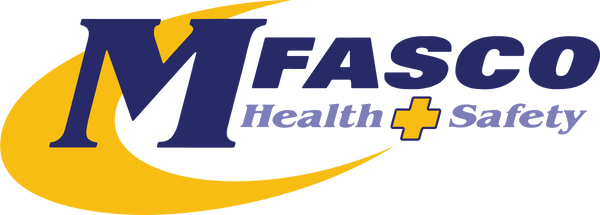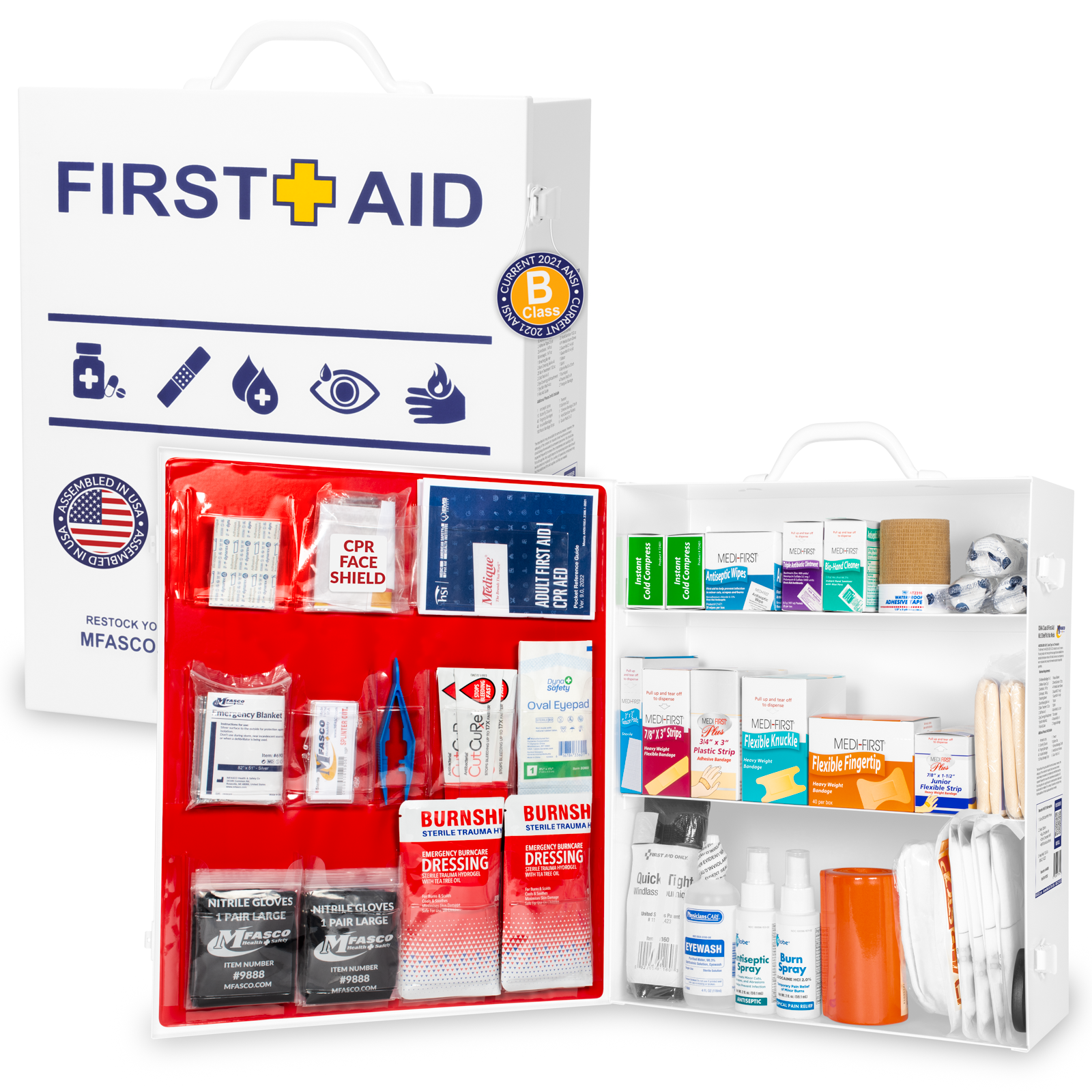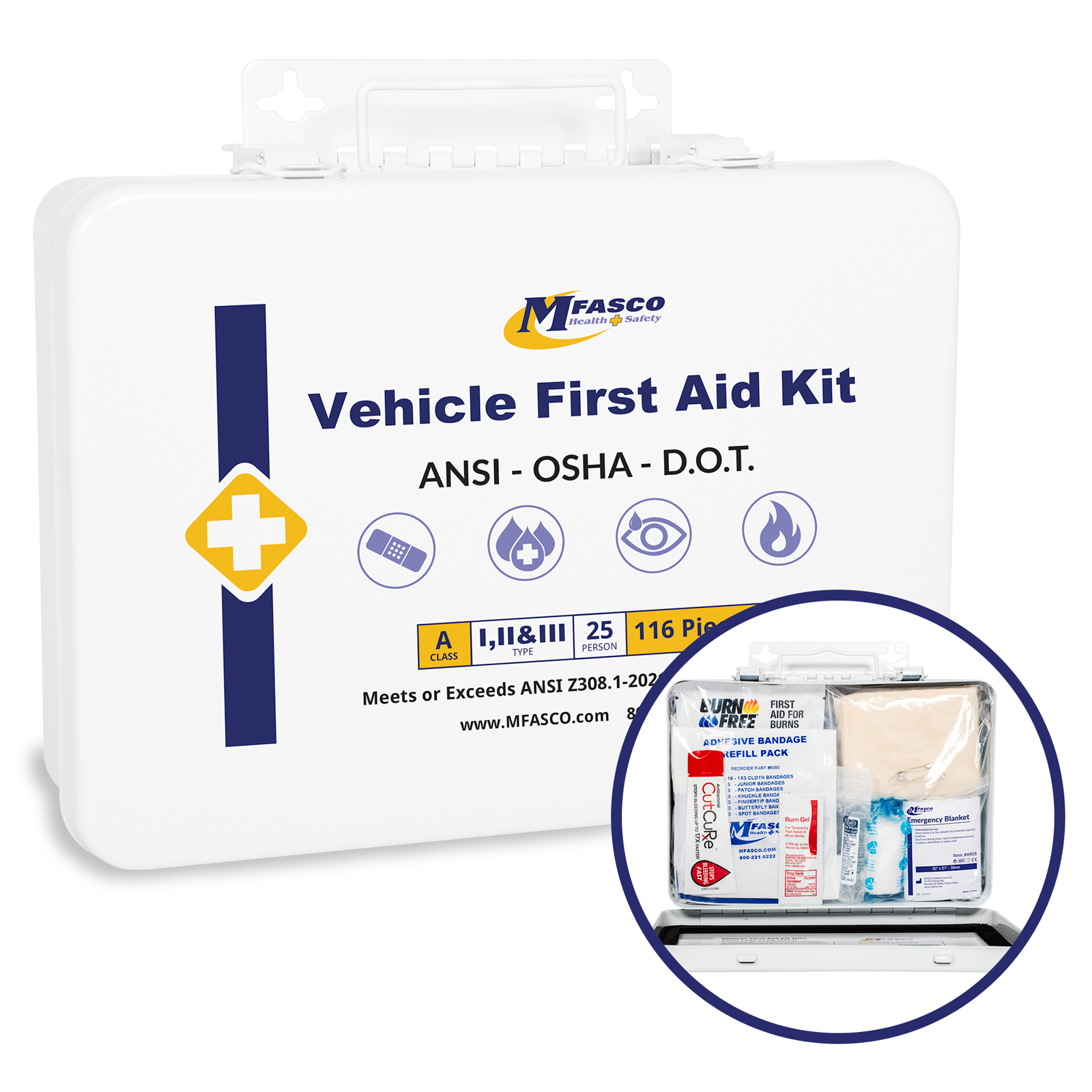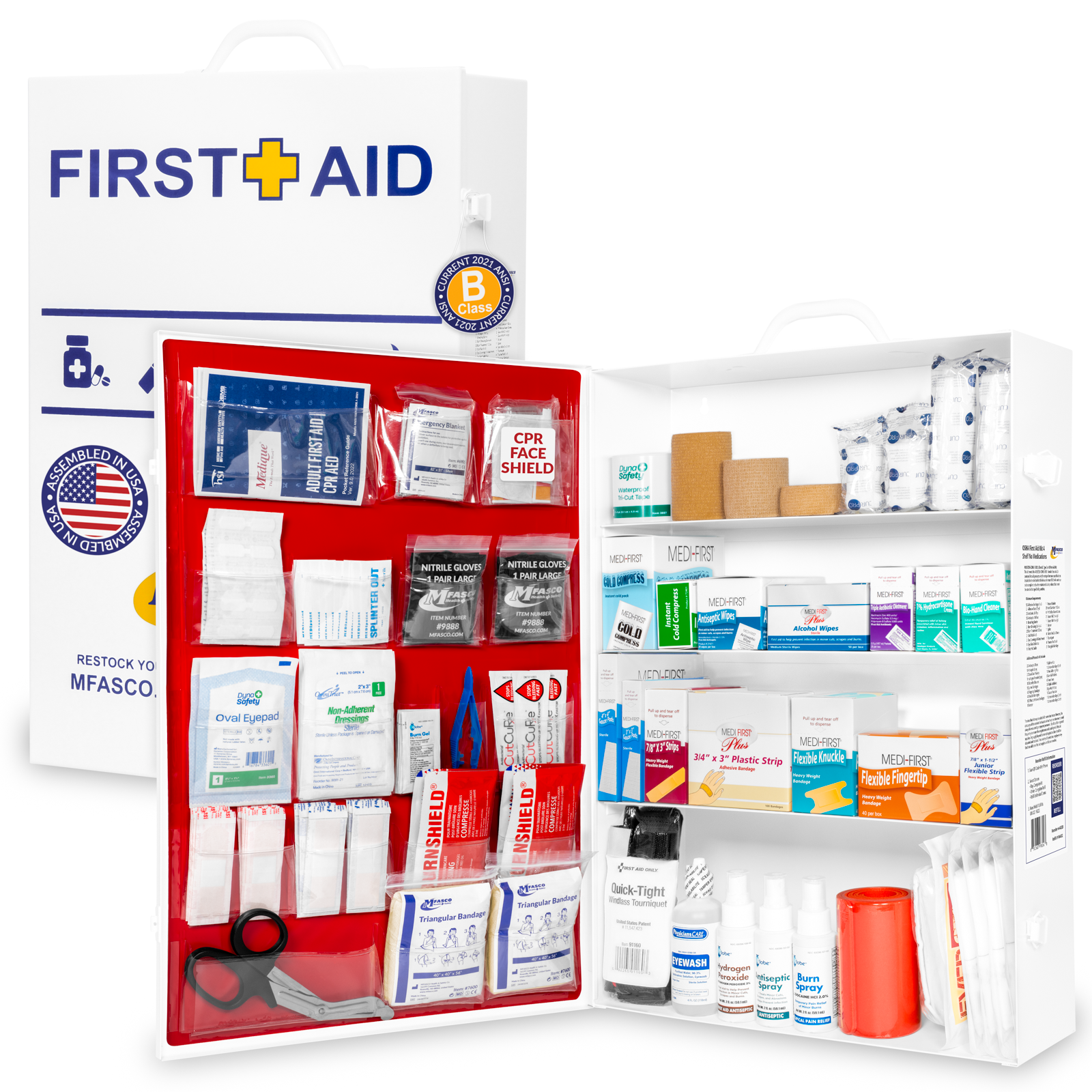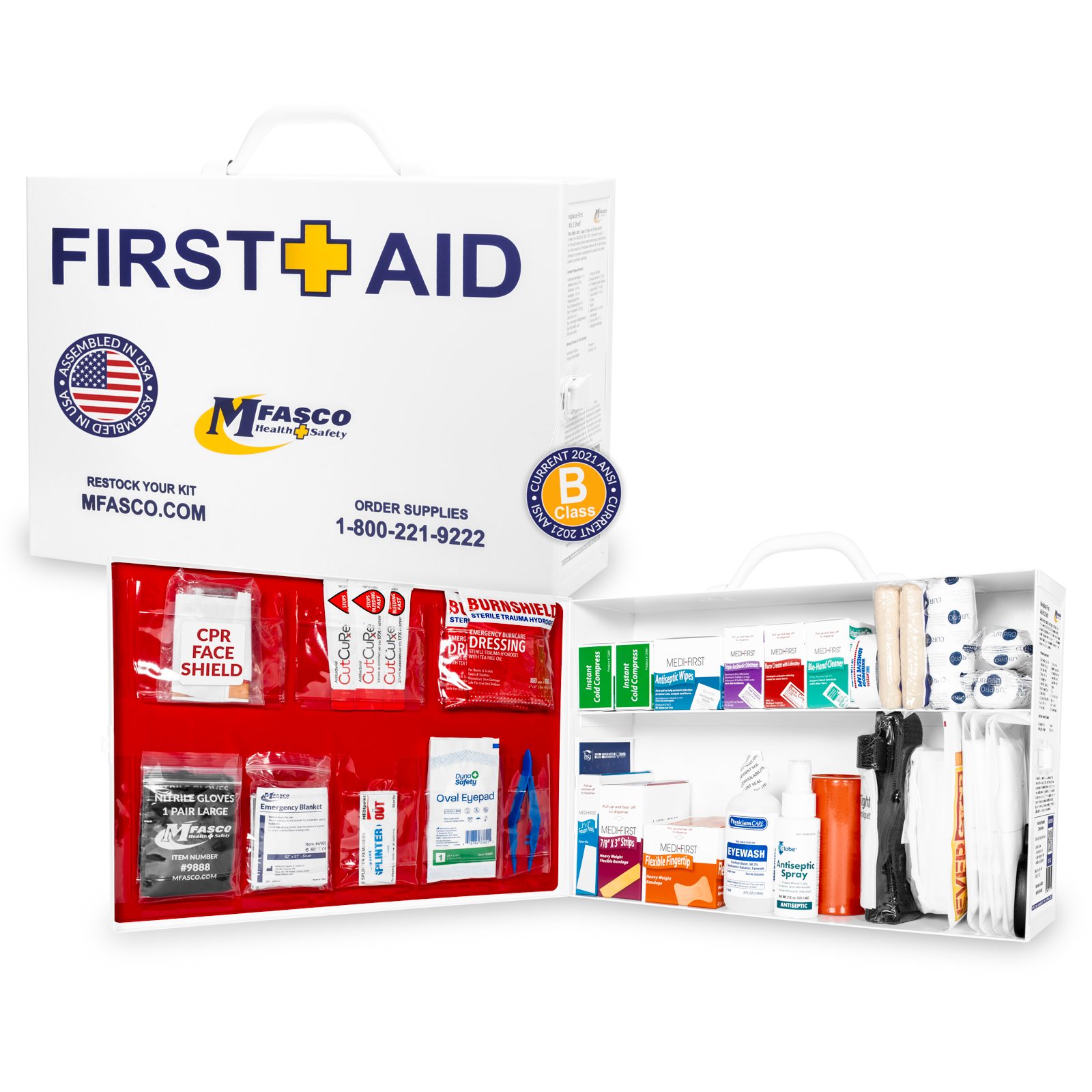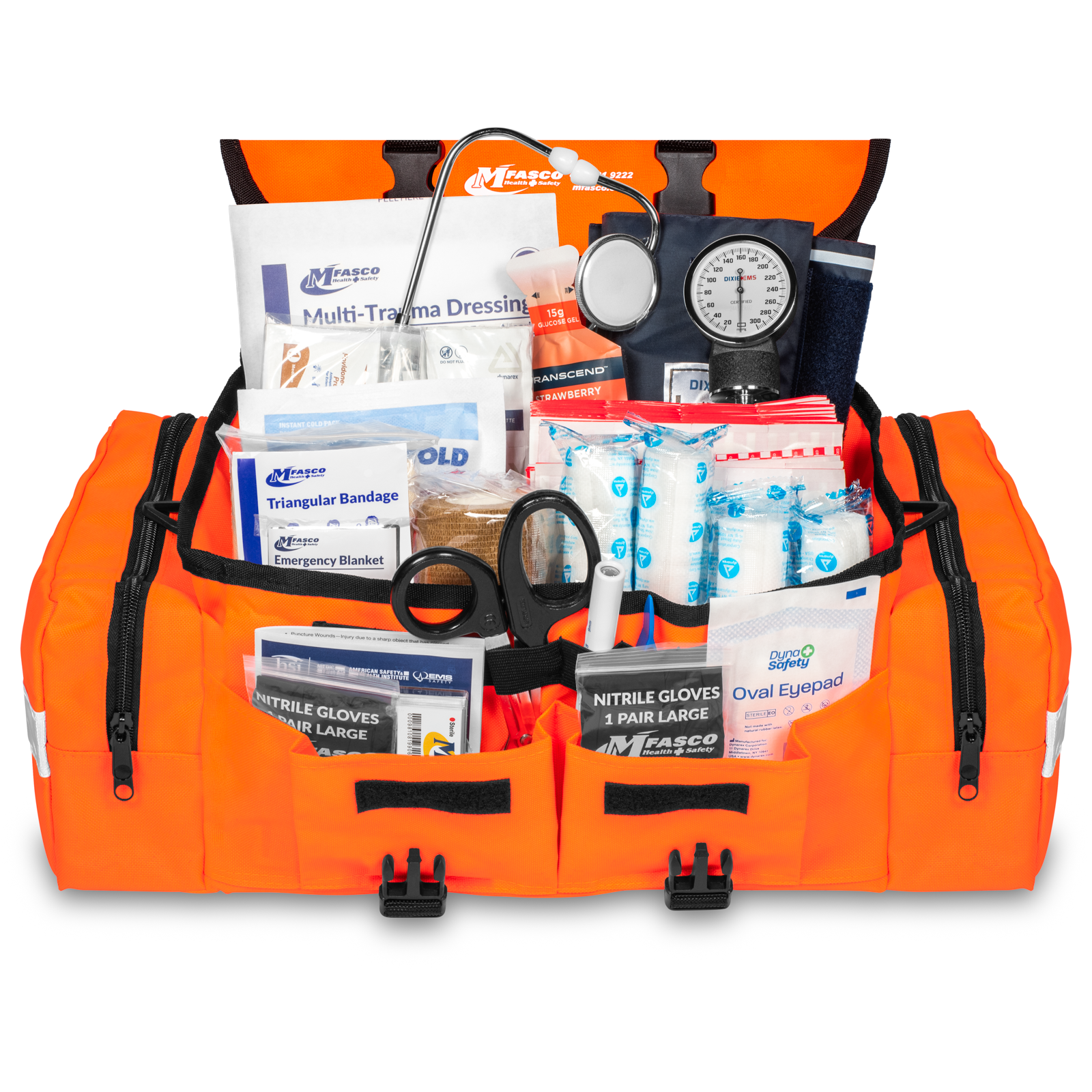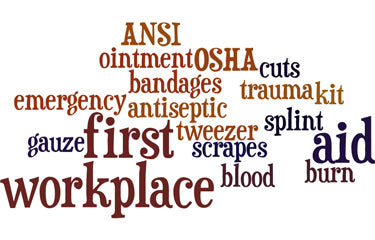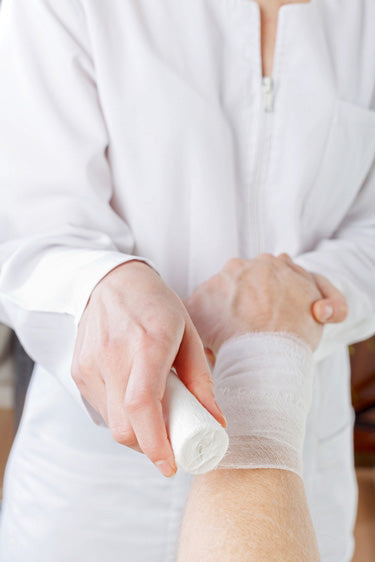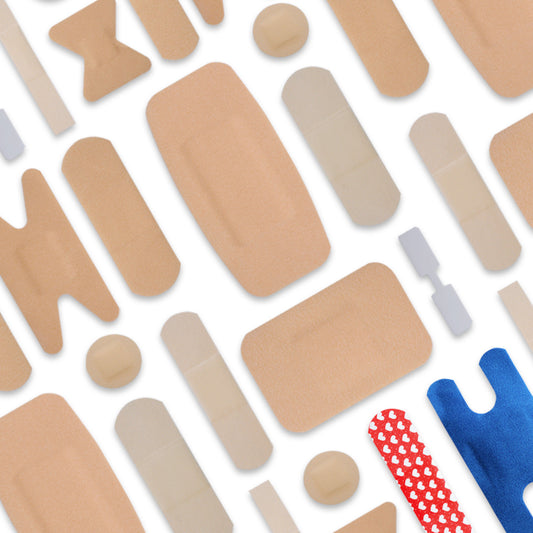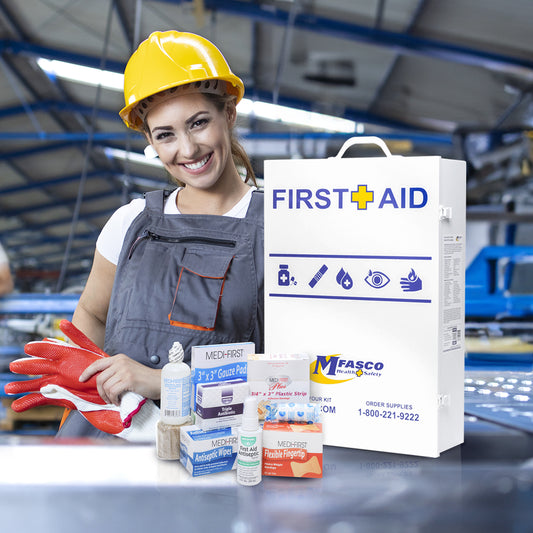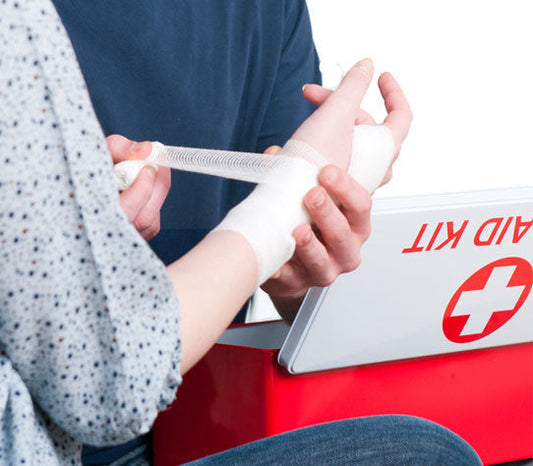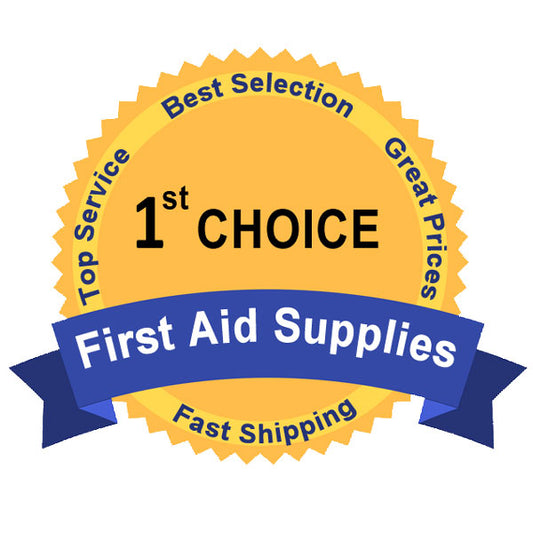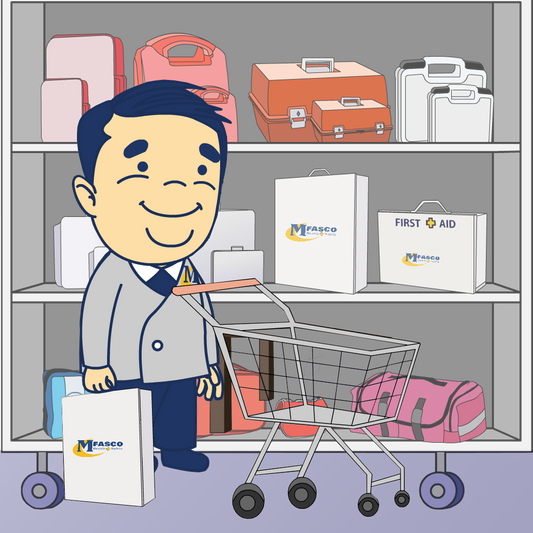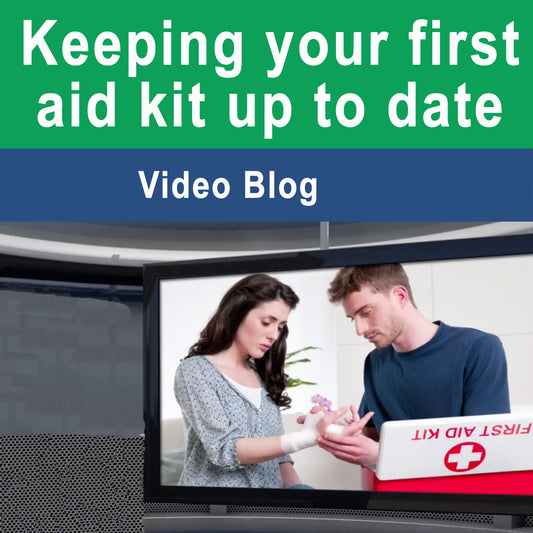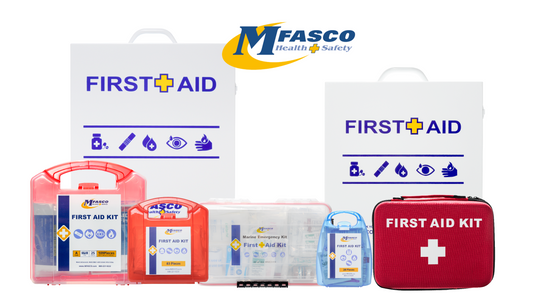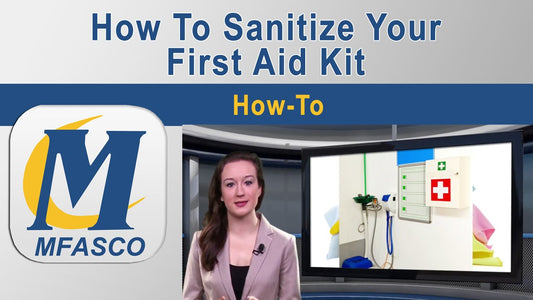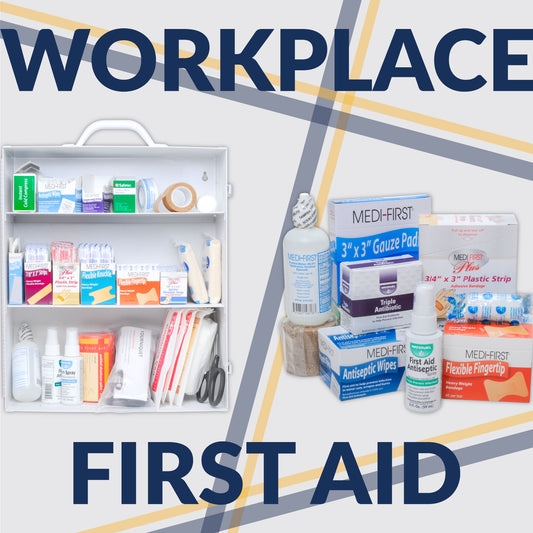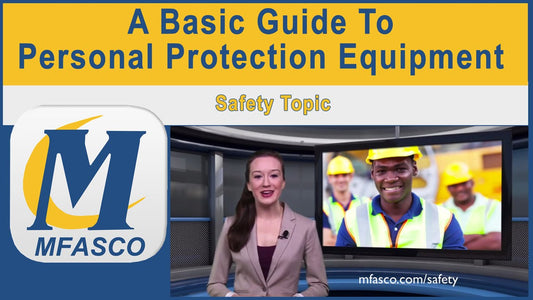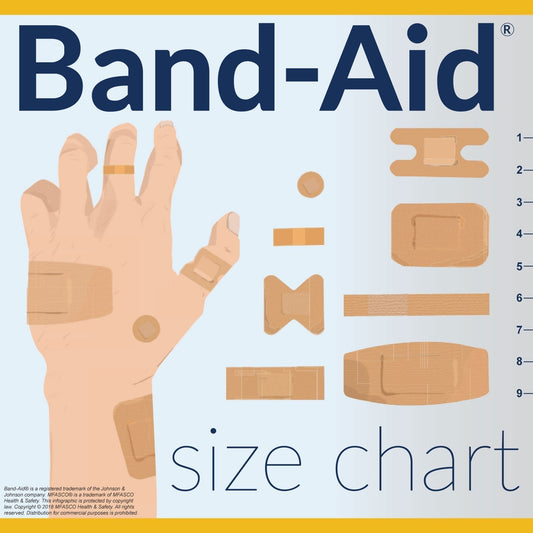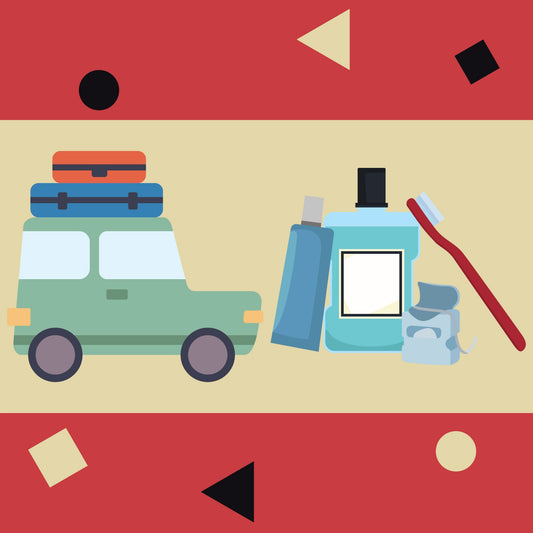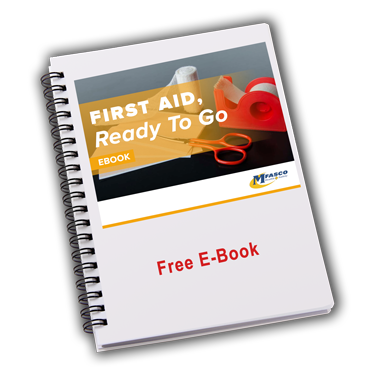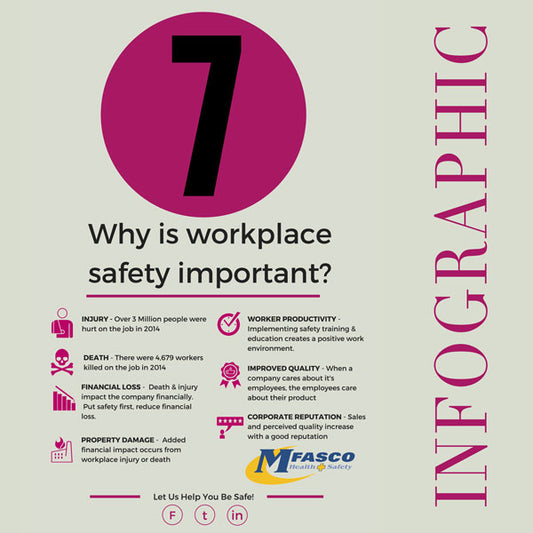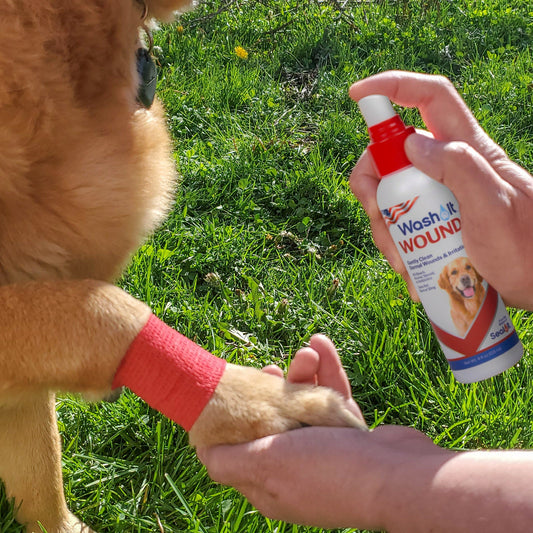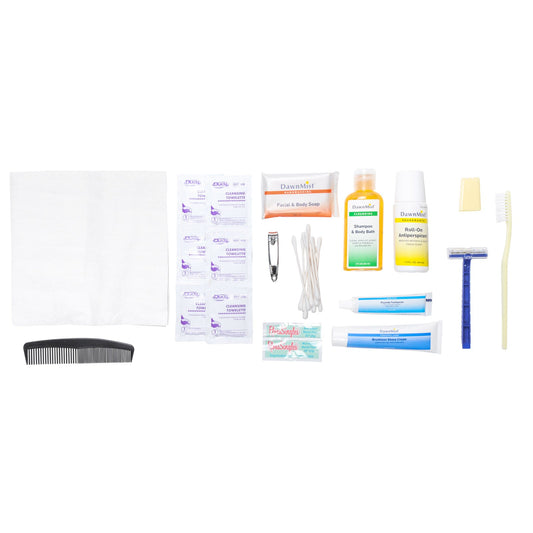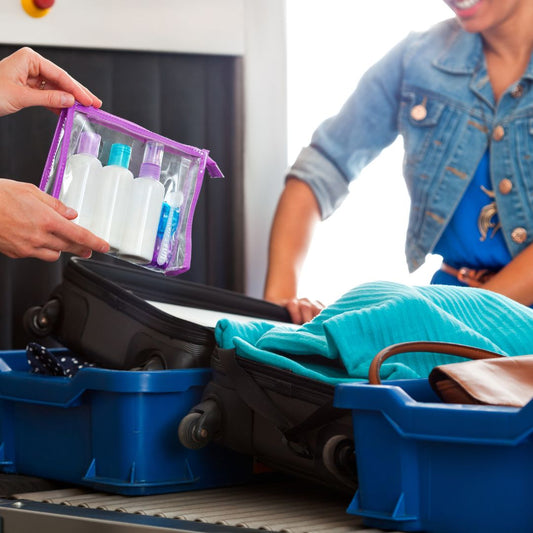ANSI Workplace First Aid Requirements
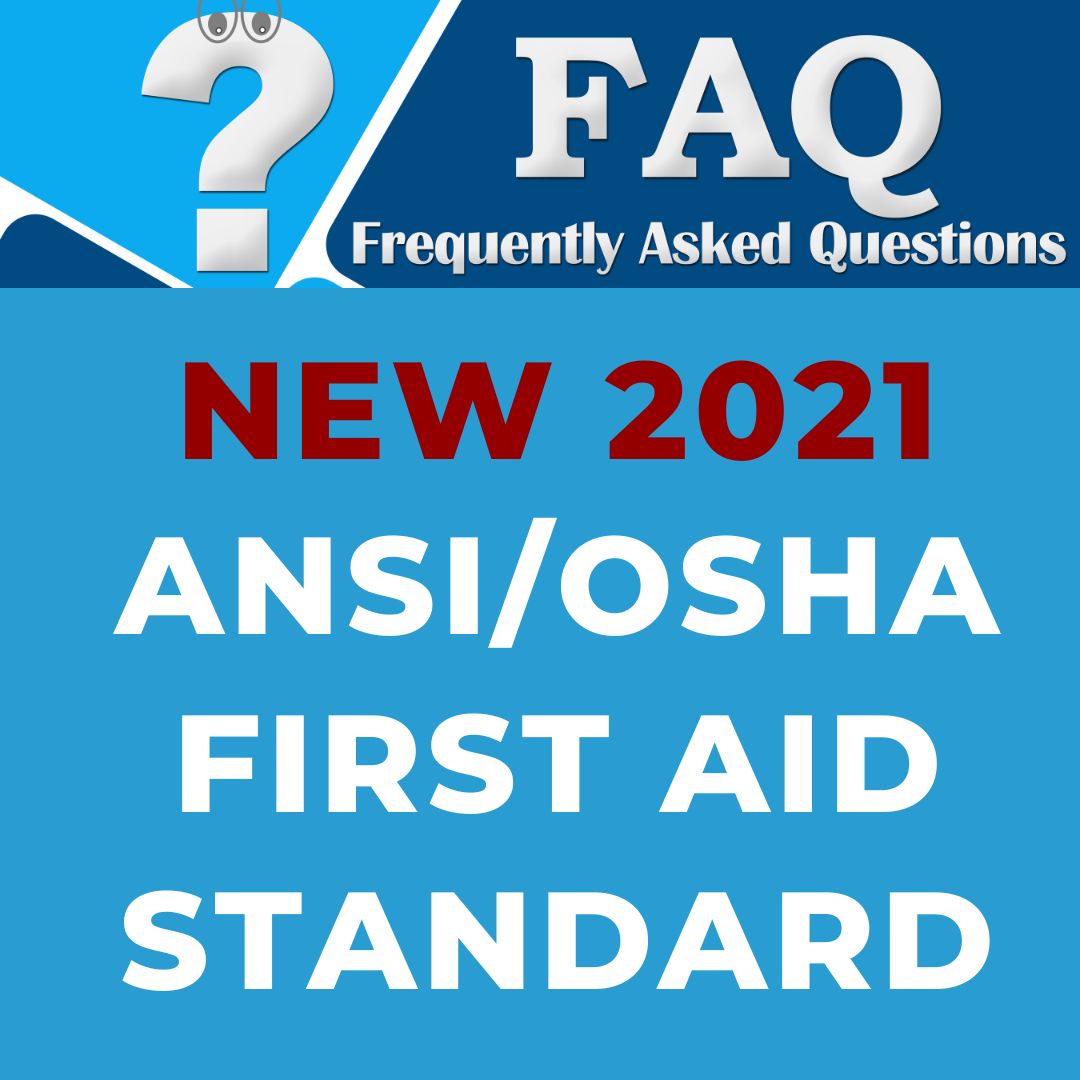
OSHA regulations say first aid supplies should be readily available in the workplace and cite the American National Standard (ANSI) Z308.1 "Minimum Requirements for Workplace First-aid Kits. Recently, ANSI updated the workplace First Aid Kits standard (ANSI Z308.1-2021) which goes into effect on October 15, 2022.
This article gets right to the point and addresses what has changed since the last standard in 2015, the complete list of required items, the type of kit you will need, how many you should have in your workplace, along with resources to answer your questions and provide guidance to help prepare your workplace to comply. Every MFASCO brand workplace first aid kit meets or exceeds the ANSI Z308.1-2021 standard. We have resources and supplies to help you update your current first aid cabinets.
Use this quick links glossary to navigate the 2021 updates.
- What has changed since the last standard in 2015?
- What first aid supplies are required by the ANSI 308.1-2021 standard?
- Do I need a Class A or Class B first aid kit for my workplace?
- How do I determine what Supplies I need for my workplace?
- How many first aid kits do I need in my workplace?
- Can other types of first aid supplies be included other than just the ANSI Z308.1-2021 list?
- How Do I Know What Container Type I Need
- Selecting Additional Products for the Work Environment
- Ongoing Maintenance of First Aid Kits
- Guidance For Bleeding Control Kits In The Workplace
- How Do I know if my first aid kit is ANSI/OSHA approved?
What has changed since the last standard in 2015?

First aid kit classifications remain the same with minor changes to the contents and quantities. Workplaces will still need to decide if they require a “class A” or “class B” first aid kit. Changes for Class A First Aid Kits:
- The addition of a foil blanket
- Hand sanitizer quantity is increased from 6 to 10 packs
Changes for Class B first aid kits:
- Hand Sanitizer quantity increased from 10 packets to 20 packets
- The addition of a foil blanket
- A military-style tourniquet is now required in all class B first aid kits
The 2021 ANSI First Aid Standard also includes some helpful guidance.
In addition to the supply list for first aid kits, the new ANSI Z308.1-2021 standard includes greater guidance for separately packaged bleeding control kits. More on bleeding control kits can be found here: (provide a link) ANSI has also clarified what additional first aid products may be needed over and above the minimum requirement. Lastly, the new standard also includes helpful information about inspecting and maintaining your first aid kits as discussed in this helpful article and video. (provide link)
What first aid supplies are required by the ANSI 308.1-2021 standard?
There are two separate lists of supplies required; One for Class A and one for Class B(see lists below).
Class A Required Minimum Fill
| 16 | Adhesive Bandage 1 x 3 in. (2.5 X 7.5 cm) | 1 | Eye/Skin Wash 1 fl oz (29.6 ml total |
| 1 | Adhesive Tape 2.5 yd (2.3 m), total | 1 | First Aid Guide |
| 10 | Antibiotic Application 1/57 oz (0.5 g) | 1 | Foil Blanket 52 x 84 in (132 x 213 cm |
| 10 | Antiseptic 1/57 oz (0.5 g) | 10 | Hand Sanitizer 1/32 oz (0.9 g) |
| 1 | Burn Dressing (gel soaked) 4 x 4 in. (10 x 10 cm) | 2 pr | Medical Exam Gloves |
| 10 | Burn Treatment 1/32 oz (0.9 g) | 1 | Roller Bandage 2 in. x 4 yd (5 cm x 3.66 m) |
| 1 | Cold Pack 4 x 5 in. (10 x 12.5 cm) | 1 | Scissor |
| 1 | CPR Breathing Barrier | 2 | Sterile pad 3 x 3 in. (7.5 x 7.5 cm) |
| 2 | Eye Covering w/means of attachment 2.9 sq. in. (19 sq cm) | 2 | Trauma pad 5 x 9 in. (12.7 x 22.9 cm) |
| 1 | Triangular Bandage 40 x 40 x 56 in. (101 x 101 x 142 cm) |
Class B Required Minimum Fill
| 50 | Adhesive Bandage 1 x 3 in. (2.5 X 7.5 cm) | 1 | First Aid Guide |
| 2 | Adhesive Tape 2.5 yd (2.3 m), total | 1 | Foil Blanket 52 x 84 in. (132 x 213 cm) |
| 25 | Antibiotic Application 1/57 oz (0.5 g) | 20 | Hand Sanitizer 1/32 oz (0.9 g) |
| 50 | Antiseptic 1/57 oz (0.5 g) | 4 pr | Medical Exam Gloves |
| 2 | Burn Dressing (gel soaked) 4 x 4 in. (10 x 10 cm) | 2 | Roller Bandage 2 in. x 4 yd (5 cm x 3.66 m) |
| 25 | Burn Treatment 1/32 oz (0.9 g) | 1 | Roller Bandage 4 in. x 4 yd (5 cm x 3.66 m) |
| 2 | Cold Pack 4 x 5 in. (10 x 12.5 cm) | 1 | Scissor |
| 1 | CPR Breathing Barrier | 1 | Splint 4 x 24 in (10.2 x 61 cm) |
| 2 | Eye Covering w/means of attachment 2.9 sq. in. (19 sq cm) | 4 | Sterile pad 3 x 3 in. (7.5 x 7.5 cm) |
| 1 | Eye/Skin Wash 4 fl. oz. total (118.3) | 1 | Tourniquet |
| 4 | Trauma pad 5 x 9 in (12.7 x 22.9 cm) | 2 | Triangular Bandage 40 x 40 x 56 in (101 x 101 x 142 cm) |
Do I need a Class A or Class B first aid kit for my workplace?
 A workplace hazard assessment is an important step towards understanding if a Class A or Class B contents list best fits the type of hazards at your place of work. Look at the types of supplies and especially the quantities to determine which Class of first aid kit your workplace will need.
A workplace hazard assessment is an important step towards understanding if a Class A or Class B contents list best fits the type of hazards at your place of work. Look at the types of supplies and especially the quantities to determine which Class of first aid kit your workplace will need.
Class A first aid kits are designed to provide a broad range of first aid products to deal with the most common types of injuries encountered in the workplace. These injuries include minor cuts and abrasions, minor burns, and eye injuries. Think of your workplace injuries that have occurred as well as the potential based on the work conditions. Also, consider how often supplies will be used.
Class B first aid kits contain a broader range and quantity of supplies to deal with injuries encountered in a more populated, complex, and or high-risk environment. Consider the types of injuries your workplace has experienced as well as the potential type of injuries that may happen broader range and quantity of supplies to deal with injuries encountered in a more populated, complex, and/or high-risk workplace environment.
How do I determine what Supplies I need for my workplace?
The ANSI Z308.1-2021 standard gives guidance to determine the types of supplies to make available in your first aid kits. Remember that Class A and Class B first aid kits contain the minimum requirements for your workplace. Your hazard assessment will determine if and what additional supplies are needed. Consider these 3 questions when conducting a Workplace Hazard Assessment:
- What are the Hazards that exist?
- What kinds of injuries have occurred or could occur in relation to these hazards?
- What types of first aid supplies are needed to treat these injuries?
How many first aid kits do I need at my workplace?
 Do not use the number of people to determine the number of first aid kits being placed at your workplace. Many first aid kit manufacturers assign a number of people their kit can supply. The ANSI Z308.1-2021 standard states in section C.2 "It is inadequate to base first aid kits and cabinets solely on the number of people in a work environment (i.e. 10-person, 25-person, 50-person or 100-person First Aid Kits)". When assessing risk, the proximity of first aid supplies in relation to each worker is imperative.
Do not use the number of people to determine the number of first aid kits being placed at your workplace. Many first aid kit manufacturers assign a number of people their kit can supply. The ANSI Z308.1-2021 standard states in section C.2 "It is inadequate to base first aid kits and cabinets solely on the number of people in a work environment (i.e. 10-person, 25-person, 50-person or 100-person First Aid Kits)". When assessing risk, the proximity of first aid supplies in relation to each worker is imperative.
When conducting a workplace hazard assessment, consider placing readily available supplies within 3-4 minutes of the hazard. Convenience, productivity, ease of access, and response time are other factors in determining where and how many supplies should be kept. Injury victims with life-threatening external bleeding must be treated immediately at the point of wounding. These factors and others can help determine where your supplies should be placed at your workplace.
Can other types of first aid supplies be included other than just the ANSI Z308.1-2021 list?
Yes, Supplemental first aid supplies can be added. It is expected that additional types of supplies, as well as quantities, will be required based on the conditions and hazards of the workplace. The selection of such items should be based on the recommendation and consultation of a person(s) competent in first aid and aware of the specific hazards found in the workplace. As always, Federal, state and local requirements should be consulted, where appropriate.
The ANSI standard lists the following items as consideration where applicable.
| OTHER FIRST AID SUPPLIES | PURPOSE |
| Adhesive Bandages of assorted sizes and styles | Effectively covers wounds of varying sizes located on various parts of the body (knuckle, fingertip) |
| Analgesics (oral and/or topical)/anti-inflammatory | Pain management; swelling control |
| Antihistamine (non-drowsy) | Allergic reactions |
| Aspirin, low-dose | Used to treat suspected heart attack |
| Electrolyte replacement | Heat-stress related injuries |
| Face mask, 3-ply, Level 1 | Used for pandemic precaution > |
| Hemostatic agent/dressing | For individuals with compromised clotting or uncontrollable bleeding |
| Hydrocortisone | Itchiness and skin-related reactions including rashes |
| Splinter remover | Removing splinters |
| Surface disinfecting wipes (EPA approved) | Helps to disinfect surfaces that may contain harmful viruses such as the common cold, flu, or coronavirus |
| Thermometer, disposable | Able to determine the risk of transferring infectious diseases from worker-to-worker |
Selecting Additional Products for the Work Environment
The ANSI Z308.1-2021 identifies two types of additional products to consider:
- OTC Medicines
- Seasonal first aid supplies
How Do I Know What Container Type I Need?

- Portability (Type II, III, IV)
- Wall Mounted (Type I, III, IV)
- Water Resistant (Type III)
- Water Proof (Type IV)
Realistically, your environment will determine what “Kit Container Type” you will need based on its performance. Will it be a portable kit stored in a construction site gang box? or maybe you need a large cabinet mounted to a wall? Each of these types has an ANSI designated container “Type”. Every ANSI-approved first aid kit is required to be identified by “Type” ensuring you are buying the correct type of container for your needs.
Ongoing Maintenance of First Aid Kits
First aid supplies should be inspected once a month or following a first aid incident when the product is used. It is important to keep your first aid kit restocked and ready to use. There are several maintenance-related tasks that should be considered during inspection including:
- Checking expiration dates
- Discarding any expired, damaged, or partially used supplies
- Organizing your supplies so they are easily identified and ready to use
- Restock all items missing or low in supply
- Disinfect and clean the cabinet/container surfaces and latches
MFASCO Health & Safety has an easy restock/refill feature for every workplace first aid kit we manufacture. Learn how to restock your first aid kit here. We use a simple 3 step approach to organize and reorder only the first aid supplies you need to stay in compliance. Always check ointments, liquids, and any other items that have expiration dates and don't forget to sanitize your first aid kit when you inspect your supplies.
Guidance For Bleeding Control Kits In The Workplace
 Careful consideration should be given to providing designated bleeding control kits. These kits contain more advanced first aid supplies to immediately treat victims with life-threatening external bleeding and such. Unique packaging will enable a first aid provider to readily access supplies. Essential bleeding control items include:
Careful consideration should be given to providing designated bleeding control kits. These kits contain more advanced first aid supplies to immediately treat victims with life-threatening external bleeding and such. Unique packaging will enable a first aid provider to readily access supplies. Essential bleeding control items include:
- Chest Seal
- Compression Bandage
- Hemostatic Bandages
- Thermal Blanket
- Tourniquet
Related kit contents include:
- Gloves
- Permanent Marker
- Shears
The MFASCO BC5 Bleeding Control Pack provides all of these supplies in a compact well marked, portable pack.
How do I know if my first aid kit is ANSI Z308.1-2021 approved?
Kits must be labeled with the appropriate ANSI 2021 minimum requirement list. Contents must meet or exceed the Class A or Class B list and kits shall be labeled to identify their class and type. All of the MFASCO OSHA/ANSI kits meet or exceed the 2021 requirements.
First Aid Products & Accessories
MFASCO's Make a Kit Tool
Complete First Aid Kit Refill Packs
Reorder Lists for First Aid Kits
Additional Resources for Reordering First Aid Kits & Supplies
Top 8 First Aid Kit Types
What is in a First Aid Kit?
Essential First Aid Kit Supply List
Contributing Expert

Mike Brinker
Mike Brinker has been working in the first aid industry for over 35 years. He has worked with thousands of businesses,groups, and organizations to provide a healthy and safe work environment. Mike helped create “Make-A-Kit”, the internet's only online first aid kit creation tool. He has also authored many helpful first-aid and safety-related resource articles found at the MFASCO Learning Center.
